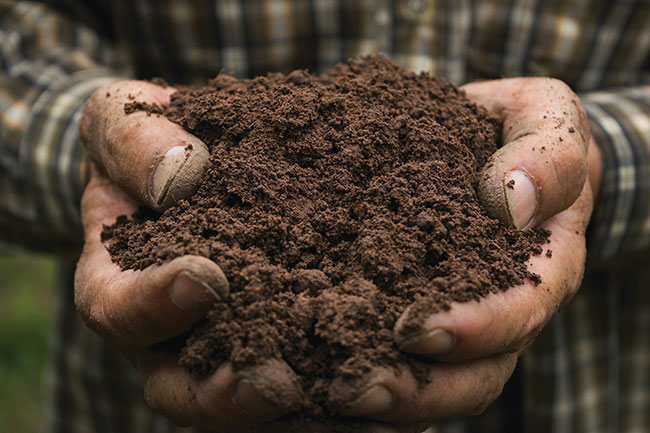
Features
Organic Perspective
Sustainability
Regenerative organic soil gets the best of both worlds
A deep dive into how regenerative organic agricultural practices can benefit soil health with Brent Preston and Gillian Flies from The New Farm.
May 24, 2023 By Stephanie Brunet | Organic Council of Ontario
 Soil quality is declining; according to Regeneration Canada, 33 per cent of soils worldwide are degraded, losing their ability to absorb water and grow plants, while
also emitting their carbon content as CO2 into the atmosphere.
Photo: mintra / Adobe Stock
Soil quality is declining; according to Regeneration Canada, 33 per cent of soils worldwide are degraded, losing their ability to absorb water and grow plants, while
also emitting their carbon content as CO2 into the atmosphere.
Photo: mintra / Adobe Stock Gillian Flies and Brent Preston own and operate The New Farm, providing high-quality organic produce to restaurants and specialty retail stores in the Toronto and Collingwood areas of Ontario. Cool-weather greens and root vegetables grow on the 20 farmed acres located in the Niagara Escarpment. Their approach to farming is “regenerative organic,” a relatively new sustainable ag method based on the Regenerative Organic Certificate developed by the Rodale Institute.
While some consider regenerative and organic practices to be one and the same – as it was in the 1930s when “regenerative” was first coined by one of the founders of organic agriculture – the Canadian Organic Standards are not always prescriptive when it comes to practices that are gaining momentum among regenerative enthusiasts, such as conservation tillage and integrating animals. Nevertheless, both regenerative and organic principles are rooted in the same common practice: building soil health.
Why soil health matters
Soil is a living matter, hosting millions of organisms and sustaining wildlife while playing a crucial role in myriad processes in the global ecosystem, including nutrient cycling, climate regulation, water retention and food provision. Despite its importance, soil health is declining; according to Regeneration Canada, 33 per cent of soils worldwide are degraded, losing their ability to absorb water and grow plants, while also emitting their carbon content as CO2 into the atmosphere. Conventional farming practices can lead to significant reductions in soil quality from erosion, compaction and pollution. “When we were doing a lot of tillage for the first 10 years of our farm, we saw that our soil started breaking down in structure, and it would dry out really quickly when we had dry spells,” Preston says.
Soil quality decline has serious implications for human and environmental health. Fortunately, regenerative organic ag implements practices aimed at mitigating these detrimental effects and restoring soil health.
Soil benefits
Regenerative organic agriculture encompasses a set of practices that aim to build a healthy and biodiverse environment by working with nature, rather than against it. These practices, such as reduced tilling, cover cropping and mulching, have a heavy focus on soil health. The overall goal of regenerative organic ag is to prioritize soil carbon sequestration, reduced erosion and increased natural soil fertility. According to the Soil Conservation Council of Canada, soil degradation is estimated to cost Canadians around $3.1 billion annually.
“We generally try to create as much biodiversity as we possibly can on the farm, in our cropping mix, in our cover crops,” Preston explains. “Outside of our productive areas, we’ve planted 10,000 trees on the farm. We do what we can to promote wildlife.”
Regenerative organic agriculture implements practices such as biological pest control, crop rotation and organic fertilizers to reduce or exclude the use of chemicals. According to data from the National Soil Project, organic farming fosters significantly higher levels of soil organic matter and sequestered carbon than conventional farming. “Organic farming practices leave the soil better than we found it,” Flies says.
Regenerative organic farmers also benefit from resistance to extreme weather conditions. Now more than ever, farmers must invest in climate-resilient operations that won’t be devastated by extreme weather events. According to the Rodale Institute, organic fields hold more water during droughts, with 15 to 20 per cent more water seeping through the soil to replenish groundwater aquifers under organic fields than conventional fields.
“In the past five years, we’ve reduced our tillage by about 70 to 75 per cent,” says Preston. “The water holding capacity of our soil has really increased since we’ve been tilling less, and we generally have faster growth of our salad greens.”
By implementing these practices on their farms, farmers can create healthier soils that are more resilient to climate change while improving soil quality for future generations. Flies says, “It will make [the soil] viable for farmers to use and thrive on in the future.”
There is no question that regenerative agriculture improves soil health, even without the organic label. However, as an unregulated movement with no set of standards governing it, there are opportunities for greenwashing. Practicing regenerative organic agriculture as defined by the ROC program simultaneously allows farmers to bridge these gaps while benefitting from a comprehensive standard and marketable brand.
New certifications and standards – such as the Regenerative Organic Alliance – raise awareness of regenerative organic benefits, encouraging not only its adoption but also stressing the potential of improving environmental and human health through enhanced soil quality.
On the topic of improving soil health, Preston says, “It’s for sure a constant challenge – we’re always learning things from other farmers and from experimenting on our farm. I think we get better every year and our soil health and the productivity of our farm increase a little bit each year, but we’re always learning new things.”
Print this page